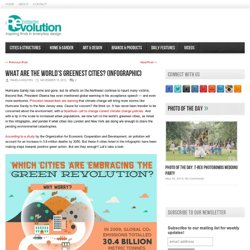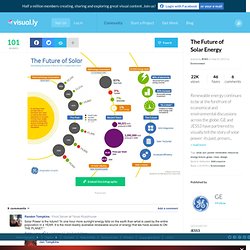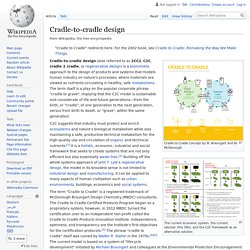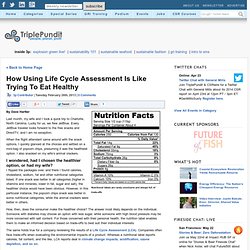

Collaborative Fund. The Scale of the Universe 2. The Interactive UK Energy Consumption Guide. An interactive data visualisation case study looking into the UK's energy consumption from 1970 to 2010. By Evo Energy. Nicholas Felton. What Are the World’s Greenest Cities - Redesign Revolution. Hurricane Sandy has come and gone, but its effects on the Northeast continue to haunt many victims.

Beyond that, President Obama has even mentioned global warming in his acceptance speech — and even more worrisome, Princeton researchers are warning that climate change will bring more storms like Hurricane Sandy to the New Jersey area. Cause for concern? We think so. It has never been trendier to be concerned about the environment, with a bipartisan call to change current climate change policies . And with a tip in the scale to increased urban populations, we now turn to the world’s greenest cities, as listed in this infographic, and ponder if what cities like London and New York are doing are enough to stave the pending environmental catastrophes.
According to a study by the Organization for Economic Cooperation and Development, air pollution will account for an increase in 3.6 million deaths by 2050. Infographic45a. How Many Gigatons of CO2? Stanford_Kay-Carbon_Footprint_Infographic-full. The Future of Solar Energy. The Future of Solar Harnessing the power of the sun for a sustainable future Historical Energy Consumption Billion kWh 1950 10,145 1960 13,214 1970 19,883 The Past Fossil Fuels Nuclear Renewable (inc, solar) In one hour more sunlight falls on the earth than what is used by the entire population in one year.

It is the most readily available renewable source of energy that we have access to on the planet. 2009 Energy Consumption 27,718 Billion kWh 83% fossil fuels 9% nuclear 7% renewable 1% solar energy Recent Years 88,221 kWh produced in 2000 1,282,560 kWh produced in 2009 $4.00 Price per Watt 2008 $2.25 2009 US Solar Industry Solar shipments (peak) Patagonia Ppt. 284092_368661679881536_24192556_n.jpg (629×603) Levis-life-cycle-analysis.jpg (537×400) LifeCycleAnalysis.png (640×480) Building lifecycle. Psaros Life Cycle. Etool LCA graphic. Life Cycle. Cradle-to-cradle design. Cradle to Cradle design (also referred to as Cradle to Cradle, C2C, cradle 2 cradle, or regenerative design) is a biomimetic approach to the design of products and systems.

It models human industry on nature's processes viewing materials as nutrients circulating in healthy, safe metabolisms. It suggests that industry must protect and enrich ecosystems and nature's biological metabolism while also maintaining a safe, productive technical metabolism for the high-quality use and circulation of organic and technical nutrients.[1] Put simply, it is a holistic economic, industrial and social framework that seeks to create systems that are not only efficient but also essentially waste free.[2] The model in its broadest sense is not limited to industrial design and manufacturing; it can be applied to many aspects of human civilization such as urban environments, buildings, economics and social systems.
Introduction[edit] Biological and Technical Cycles Biological and technical cycle Health[edit] Life-cycle assessment. Life-cycle assessment (LCA, also known as life-cycle analysis, ecobalance, and cradle-to-grave analysis)[1] is a technique to assess environmental impacts associated with all the stages of a product's life from-cradle-to-grave (i.e., from raw material extraction through materials processing, manufacture, distribution, use, repair and maintenance, and disposal or recycling).

LCAs can help avoid a narrow outlook on environmental concerns by: Compiling an inventory of relevant energy and material inputs and environmental releases;Evaluating the potential impacts associated with identified inputs and releases;Interpreting the results to help make a more informed decision.[2] Life Cycle Assessment Overview Goals and purpose[edit] How Using Life Cycle Assessment Is Like Trying To Eat Healthy. Nutritional labels are rarely conclusive and always full of trade-offs By Dave Hartter Last month, my wife and I took a quick trip to Charlotte, North Carolina.

Lucky for us, we flew JetBlue. Every JetBlue traveler looks forward to the free snacks and DirectTV, and I am no exception. When the flight attendant came around with the snack options, I quickly glanced at the choices and settled on a mini-bag of popcorn chips, presuming it was the healthiest option. I wondered, had I chosen the healthier option, or had my wife? 3 myths about product life cycle assessments. Depending on what you read in the green building press right now, you could be left with the impression that life cycle assessment (LCA) is either the next big thing or fatally flawed and missing key criteria for evaluating green building products.
On one hand, the major overhaul of the Leadership in Energy and Environmental Design (LEED v4) standard , due out in November, will write LCA into the world's dominant green building standard at both the building and product level. On the other hand, green building advocates have been quick to critique the ease with which LCA can be used for greenwashing, the questionable quality of the data it generates and its failure to include life cycle toxicity impacts.
As a building products company that has used LCA since 2000, Interface has a strong interest in having LCA understood and applied correctly. Next page: Myth No. 1: Greenwash Magnifying glass image by Laborant via Shutterstock . The Time of My Life Cycle. You've probably heard the term at some point or undoubtedly read about it in other posts : "life cycle assessment" (sometimes "life cycle analysis" or "LCA"), that fascinating methodology that considers the impacts of a product or process from "cradle to grave" or " cradle to cradle " depending on where it ends up. It's time to get to it and to understand what all this LCA hype is about. Let's start by understanding what a life cycle is.We hear a lot of tips on how reduce our ecological footprint , including one of the essentials — buy local products .
Why? It comes back to product life cycle. PLC is originally a marketing term used to define all of the development stages of a product. Why worrying about food miles is missing the point. In November 2009, I lost my temper in front of a bank of television cameras in a way I have never done before or since. I was in Los Angeles working as a judge on the second season of the American TV series, Top Chef Masters . For the final, the three remaining competitors had been asked to cook a series of dishes that told their story: their first food experiences, where they are now, where they are going and the like. For the dish that defined where he was going, the famed Las Vegas-based chef Rick Moonen had cooked a venison dish, using meat imported from New Zealand.
This was baffling. Sustainable Minds LCA demo. BLP Butterfly: low carbon design & decision tool (BLP Insurance) Nike / Reuse-a-Shoe. Life Cycle Assessment - It's the only way to drive! Life Cycle Assessment. US Energy Projections. Syngenta - Pictures. Life Cycles OFFICIAL Trailer. Catherine Mohr builds green. The Road to Sustainable Success - ESP Software SoFi 5 by PE INTERNATIONAL. The Story of Bottled Water (2010) My Green Home Rating Tool. Working with eTool. About eTool LCA. New Inventors: eTool. eTool It is a software program and database that uses engineering principles to calculate with a high level of accuracy the carbon footprint of a house throughout its entire lifecycle, from materials and construction, through occupancy to the end of its usefulness and beyond.
It will tell you the embodied energy consumption in the materials you choose, as well as the energy efficiency of the house and even calculate the carbon cost of maintenance and repainting during the building’s lifetime. It can calculate and report numerical results for comparative building designs including carbon emissions, energy use, water use, land use and habitat loss, resource use and recyclability. Green Building - Leading By Example.